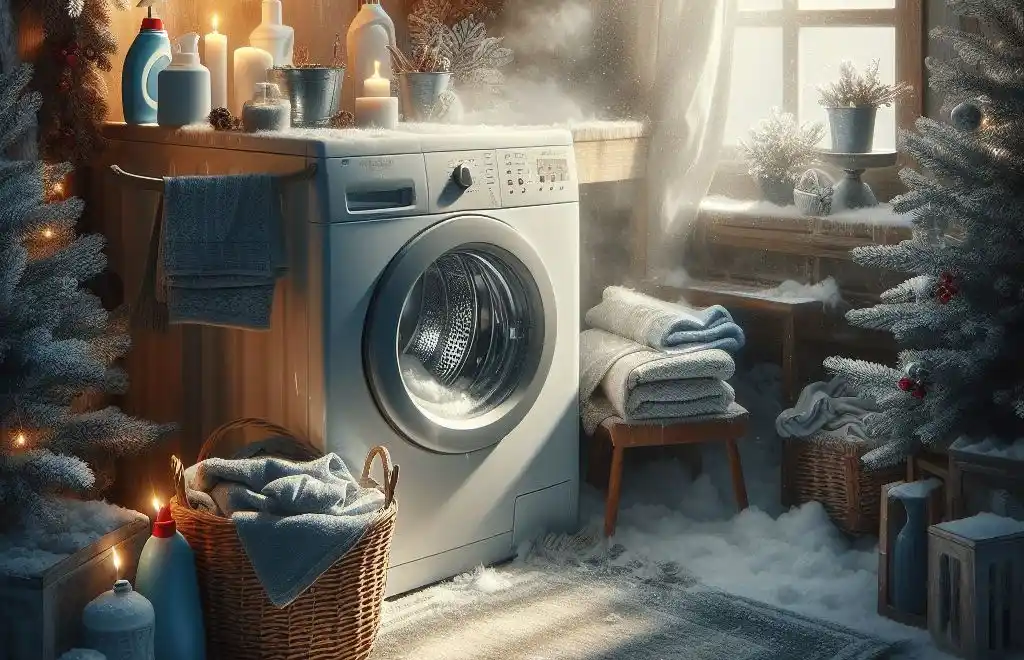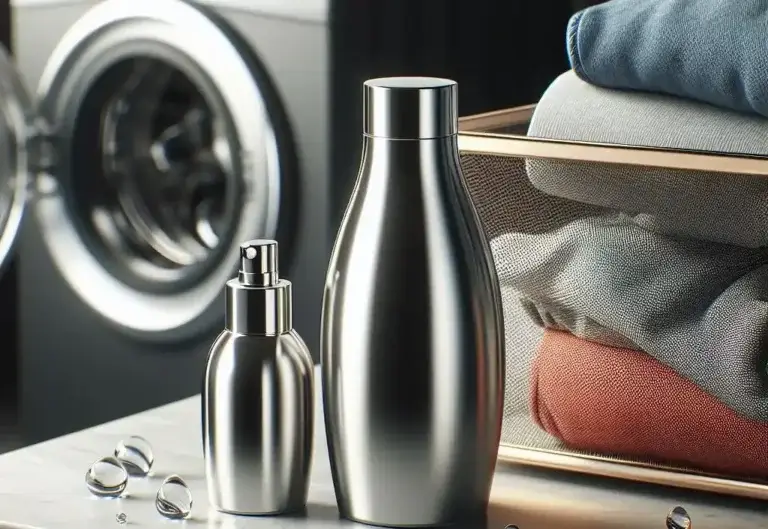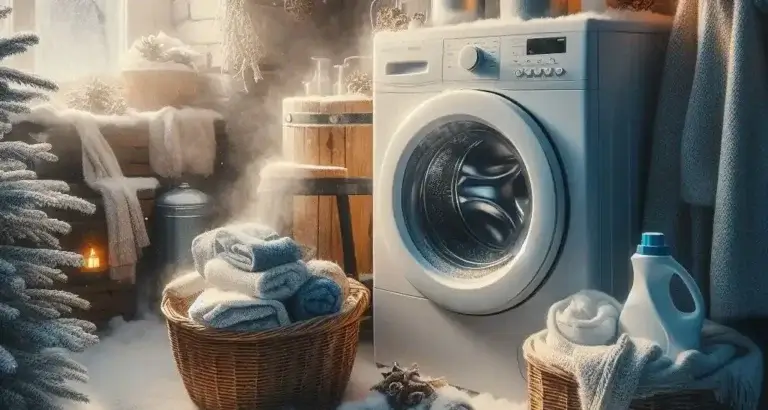Can a Washing Machine Freeze? How to Winterize Your Washer
Are you wondering if your washing machine can freeze during the cold winter months? Freezing temperatures can impact washing machines left in unheated areas like garages or basements. When water freezes it expands, which can lead to burst pipes, disconnected hoses, and damage to your washer.
The good news is that with some simple preparation, you can winterize your washing machine to prevent freezing issues. This will save you from expensive repairs and allow you to keep using your washer all winter long. In this comprehensive guide, we will cover can a washing machine freeze, including :
- Can washing machines freeze?
- What happens when a washing machine freezes?
- Preventing washing machine pipes from freezing
- How to winterize a washing machine
- Using RV antifreeze in a washing machine
- Keeping washing machines in cold garages or basements from freezing
- FAQs about washing machines and winter weather
If your washing machine is located where temperatures may dip below freezing, this winterization guide is a must-read. Protecting your appliance now will save you money and headaches later on. Let’s get started!
Table of Contents
Can a Washing Machine Freeze?
Yes, washing machines can freeze during cold winter temperatures. Washing machines have water supply lines for the hot and cold water hookups. They also contain some residual water in the hoses, pump, and drain lines.
If your washing machine is exposed to below-freezing temperatures without taking preventative measures, this standing water can freeze. As water freezes and turns to solid ice, it expands in volume. This expansion puts pressure on the internal washing machine parts and connection points.
The results of a washing machine freezing can include:
- Burst water lines or supply hoses
- Cracks in the washing machine tub
- Leaking valves and connections
- Damage to electronic control boards
- Malfunctioning drain pumps
Many modern washing machines have some freeze prevention measures built in. However, prolonged or extreme freezing temperatures can still cause ruptures, leaks, and mechanical failures.
Checking the owner’s manual for your specific washing machine model will provide details on its freeze tolerance. But any washer left unprotected in sub-freezing conditions risks possible damage.
What Happens When a Washing Machine Freezes?
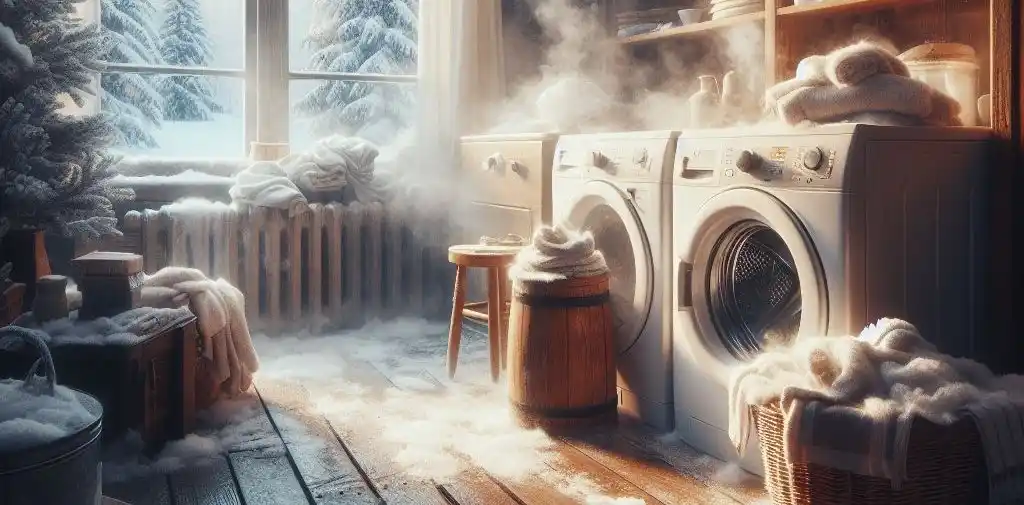
To understand what happens when a washing machine freezes, it helps to visualize where all the water is located. There are three main areas:
- Water supply lines: These hook up to your home’s hot and cold water pipes to feed water into the washer. Supply lines and valves remain partly filled with water even when not actively running a load. It’s important to drain the water to prevent freezing.
- Internal hoses & pump: Most washers have rubber drain hoses as well as circulation pumps with some residual water left inside after cycles finish.
- Drain line: This removable drain hose feeds down to a drain pipe or laundry sink. There is usually some trapped water down the hose.
If your washing machine reaches freezing temperatures (32° Fahrenheit or below), any water left in these areas will freeze and expand. The ice puts intense pressure on surrounding parts.
The most vulnerable components are plastic or rubber hoses and water line connections. These can crack open, causing major leaks. If the internal pump housing splits, not only will it fail to drain properly, but leaks can damage control boards and other components.
Frozen solenoid water valves will stay stuck open or closed. They can burst internally leading to electrical shorts or external leaks. The rigid mounting points to the machine tub or case will also crack under stress from the water pressure if not winterized.
In severe freeze events, the machine tub itself might rupture from expanding ice. This can happen in top-loaders where some water collects in crevices. The inner drum may become distorted as well.
To prevent damage, washing machines in areas prone to freezing need precautionary winterization. Let’s go over methods for protecting washing machines from burst pipes and mechanical harm.
Preventing Washing Machine Pipes from Freezing
If temperatures regularly drop below freezing where your washing machine is located, there are several things you can do to avoid frozen pipes:
- Disconnect hoses & drain water – Removing the water hookups and draining all residual water will eliminate freezing risk. Make sure the washer tub and pump areas are fully emptied as well.
- Insulate pipes & valves – For washing machines you plan to keep using in cold spots, wrap any exposed water pipes and valves with specially designed insulation products. This helps regulate temperature.
- In response to cold temperatures, use heat trace cables to keep the water in the machine from freezing. – Running electric heat cables along plumbing and washer water lines warms them enough to block freezing in sub-zero temps. The heating wires are wrapped around pipes.
- Install heat lamps or space heaters – Strategically placed portable heaters directing warmth on your washing machine and supply lines will greatly lower freeze potential. Just take fire hazards into account.
- Shut off main water supply – If you won’t be doing laundry for an extended period, shutting off the water valves leading to the washer depriving the pipes and hoses of liquid that could freeze.
- Consider relocating the unit To avoid cold temperatures, can the washing machine be moved to a heated area not prone to freezing, at least during the winter season? This removes all chance of ice damage.
Taking a few or all of these precautions will safeguard washing machine plumbing from bursting due to frozen water expanding. Next, let’s review the full machine winterization steps.
How to Winterize a Washing Machine
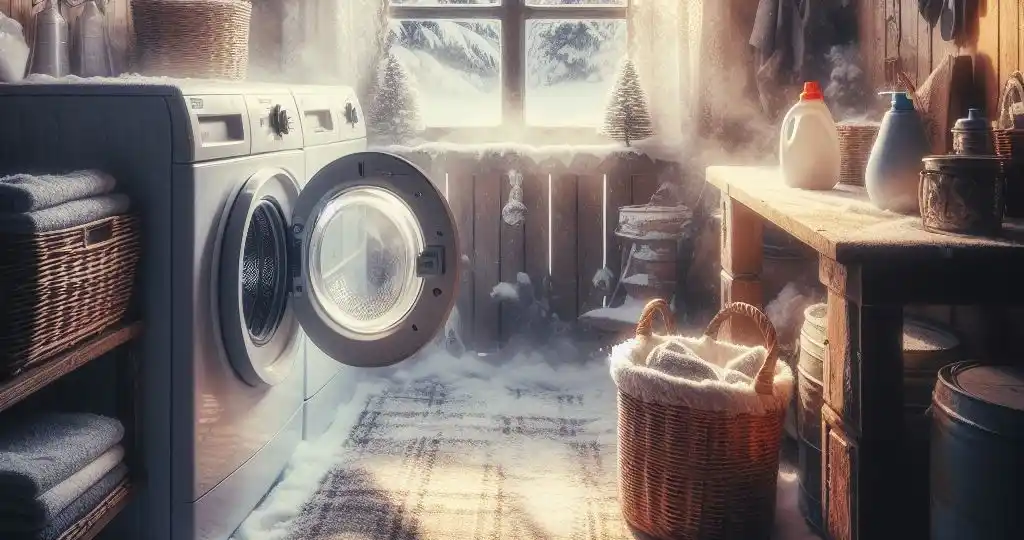
For washing machines that must stay in unprotected spots with sub-freezing temperatures, winterizing the appliance is essential. Here is a step-by-step guide:
Prep Work
- Clear away detergent, clothes, etc: Remove any soap, fabric softener, or bleach bottles from the top of the washer. Also, take out any lingering wet clothes or other items.
- Disconnect hoses: Unscrew the hot and cold water-fill hoses from the rear of the machine. Also, unhook the drain hose from the outlet or standpipe.
- Shut off water valves: Turn the water valve knobs completely off for both supply lines feeding the washing machine.
Drain-All Water
- Advance spin cycle: Turn ON the washer and run it through the spin cycle for 1-2 minutes. This will eject some trapped water.
- Tip unit back: Carefully lean the washing machine back on its rear frame 4-6 inches. Support it so it stays balanced at an angle to prevent any damage to the machine.
- As a need to winterize, manually drain hoses to get rid of any amount of water in the machine.: With the washer tilted, drain any remaining water from the disconnected hoses and pump outlet. Use towels if needed.
- Return unit flat: Once fully drained, gently stand the washer upright on all four feet again.
Add RV Antifreeze
- Pour into detergent tray: Add 1-2 gallons of RV antifreeze to the washer detergent tray for front-loaders, or directly into the empty tub on top-loaders.
- Advance short cycleTurn ON the machine for 1-2 minutes to circulate antifreeze into the interior hoses and pump mechanism. This will ensure the water pressure doesn’t cause damage to the machine.
- More antifreeze if needed: Check if pink RV antifreeze flows fully through the drain outlet hose. If not, add more antifreeze and run another short cycle.
- Turn OFF & unplug: When antifreeze flushes the drain hose, turn OFF and unplug the washing machine from electric power.
Congratulations! You have successfully winterized the unit for the winter season. The non-toxic RV antifreeze will keep internal hoses, pumps, and pipes from freezing all winter long in sub-zero temps.
Reverse these steps above when warmer weather returns, flush out the antifreeze and reconnect hoses. The washer will be ready for normal operation again.
Using RV Antifreeze in a Washing Machine
The key element that makes washing machine winterization effective is pouring in RV antifreeze. This is essentially a non-toxic antifreeze that circulates through plumbing systems and appliances to prevent freezing. It goes by a few different product names:
- Use RV & Marine Antifreeze to winterize and protect the machine during cold temperatures.
- Drinking Water System Antifreeze
- Potable Water Antifreeze
- Eco-Friendly Antifreeze
But they all perform the same protective function. RV antifreeze stays liquid down to -50° Fahrenheit, creating a shield against pipes and hoses freezing solid. It flows smoothly through pumps and valves so nothing gets stuck.
The antifreeze is formulated to be harmless for human consumption and the environment. So it will not contaminate your machine or clothes. Any residual fluid left over after winter or flushing is non-toxic.
Using 2-3 gallons of RV antifreeze to winterize washing machines is recommended. Make sure to circulate it through the entire internal system by running short wash cycles. Any standing water left will be safely displaced when you run water to drain the machine.
Now let’s review another common freezing scenario: keeping laundry appliances in detached garages or basements prone to freezing temperatures.
Keeping Washing Machines in Cold Garages or Basements from Freezing
Many homes utilize garage laundry rooms or basement installations. But these areas often dip below freezing during frigid winter weather. Special steps must be taken to protect washing machines and prevent cracked pipes.
Here are ways to insulate laundry appliances and plumbing fixtures in cold basement or garage settings:
- Maintain consistent ambient heat – Install permanent heating sources like radiators, space heaters, or heat lamps positioned near pipes and washing machines. Hold the interior temperature at or above 40° F.
- Insulate water lines & valves – Wrap foam or fiberglass insulation sleeves around the water supply pipes leading to laundry machines. Pay particular attention to plumbing fixtures nearest the exterior walls.
- Install insulation behind units – Placing insulation batting, foam boards, or vinyl curtains behind wall-mounted appliances adds an extra cold barrier blocking drafts and freezing.
- Leave cabinet doors open – For laundry pairs or stacked units enclosed in cabinets, keep the cabinet doors completely open when running cycles. This allows ambient heat circulation behind the appliances.
- Consider laundry tub covers – Custom plastic laundry tub lids help retain heat and block moisture over top-loading washing machine tubs. Some even have insulation inside.
With adequate insulation methods and temperature regulation, washing machines and laundry plumbing can survive frigid winters even in detached external structures. This is particularly important in the winter season. Preventing drafts and adding heat barriers keeps the interior climate controlled.
Frequently Asked Questions
What temperature will a washing machine freeze at?
Washing machines will typically freeze when interior parts like hoses and pumps reach 32° F or lower. Extended freezing causes damage.
Where is a washing machine most likely to freeze?
Areas most vulnerable to freezing damage are the water inlet hoses, circulation pump, and drain outlet hose. These all hold residual water that can expand.
What should I do if my washing machine froze?
Do not attempt to use a washing machine you suspect froze. Call appliance repair technicians to inspect for cracks and leaks. thawed. Replacement parts may be needed before safely running washer cycles again.
How can I prevent my washing machine from freezing this winter?
To prevent freezing issues, disconnect all water lines and drain the machine fully. Use RV antifreeze to winterize the unit. Maintaining above-freezing ambient temperatures also helps.
Is it OK to leave RV antifreeze in my washing machine?
Yes, RV antifreeze designed for potable water systems is harmless to washing machine parts. It can be left in the machine all winter until you flush it out in spring.
Key Takeaways: Protecting Washers from Freezing
- Exposure to freezing temperatures can damage washing machines via ruptured hoses, leaks, electrical shorts, etc.
- Water left inside supply lines, pumps, and drain hoses expands as it freezes, cracking plastic and metal parts.
- Winterizing washing machines by draining systems and adding RV antifreeze keeps liquid flowing safely in sub-zero conditions.
- Insulating supply pipes and maintaining heat around washing machines prevents freezing issues.
- Running spin cycles and tilting units when draining maximize water removal for winter.
- Check your owner’s manual for model-specific freeze tolerance info and tips.
Safeguard your washing machine from burst hoses, costly repairs, and mechanical failures this winter. Follow our winterization and freeze-proofing guide to keep laundry running smoothly all season!

